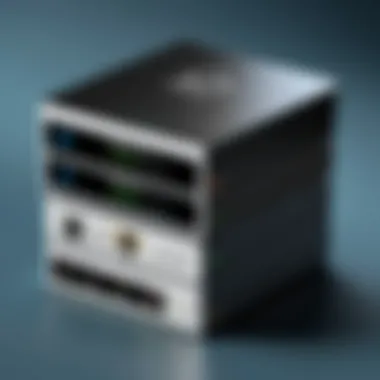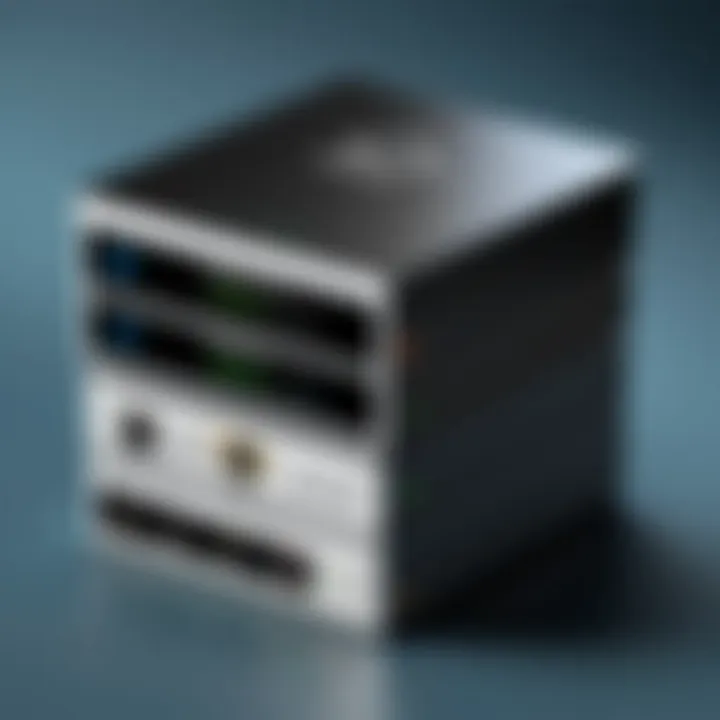Set Up Your Own VPN Server at Home Easily


Intro
Creating a VPN server at home can appear daunting to many individuals. However, it represents a significant step towards protecting your online privacy and enhancing your security. By having your own VPN, you control your data and access content securely. This guide walks through the essential factors involved in establishing a home VPN server. We will explore the prerequisites, configuration options, and how to navigate potential challenges.
Overview of Cyber Security Threats
In today’s digital age, understanding the threats that lurk online is vital. Without this knowledge, users often become unwitting victims.
Types of Cyber Threats
Cyber threats come in various forms. These include:
- Malware: This encompasses viruses, worms, and trojan horses that infect systems, often without user knowledge.
- Phishing: A tactic used by attackers to trick users into providing sensitive information by mimicking trustworthy entities.
- Ransomware: A malware type that locks users’ files, demanding payment to restore access.
Statistics on Cyber Attacks
Data from various studies reveal startling insights:
- In 2022, cyber attacks increased by over 40% compared to the previous year.
- A significant 60% of small businesses close within six months after a cyber attack.
Real-life Examples of Security Breaches
Incidents such as the Equifax breach in 2017 and the WannaCry ransomware attack illustrate the real dangers of inadequate security. They demonstrate the financial and reputational damage that can occur from poor cyber defense.
Best Practices for Online Security
To mitigate risks, adopting best practices is essential. This section outlines key strategies for online safety.
Strong Password Creation and Management Techniques
Creating robust passwords is a basic yet crucial defense measure. Utilize a mix of letters, numbers, and symbols. Additionally, implement a password manager to keep your credentials secure.
Regular Software Updates and Patches
Keeping software up to date is vital. Regular updates address vulnerabilities that cyber attackers may exploit.
Two-factor Authentication Implementation
Two-factor authentication adds an extra layer of security, making unauthorized access significantly harder. Whenever possible, enable this feature on all accounts.
Reviews of Security Tools
Evaluating different security tools is essential. This allows users to make informed decisions.
Evaluation of Antivirus Software Effectiveness
A robust antivirus program can detect and remove known threats. Look for options like Norton and Kaspersky that offer comprehensive solutions.
Comparison of Firewall Protection
Different firewalls offer varying levels of protection. Consider your specific needs when choosing between software or hardware firewalls.
Assessment of Password Managers
Password managers can improve password security. Tools such as LastPass and 1Password provide features that enhance usability and protection.
Tips for Ensuring Online Privacy
Understanding privacy is as crucial as security. Here are essential insights to keep personal data safe.
Importance of Using VPNs for Secure Browsing
A VPN encrypts your internet connection, shielding your data from prying eyes. It allows private communication and a secure browsing experience.
Privacy Settings on Social Media Platforms
Regularly check and adjust privacy settings to control what information is shared. Many platforms, including Facebook, offer advanced options for user privacy.
Protecting Personal Data When Making Online Transactions
Always verify the legitimacy of shopping sites. Use secure payment methods to protect sensitive financial information.
Educational Resources and Guides
Numerous resources can enhance understanding of cybersecurity. Explore:
- How-to articles on setting up encryption tools.
- Step-by-step guides on spotting phishing emails.
- Cheat sheets for quickly enhancing online security practices.
By implementing the strategies and best practices discussed in this guide, individuals can significantly improve their online security and privacy. Utilizing a VPN at home is a beneficial move toward securing your network.
Understanding VPN Technology
Understanding Virtual Private Network (VPN) technology is crucial for individuals looking to enhance their online security and privacy. In an era where digital surveillance and data breaches are common, grasping how VPNs operate can empower users to protect their personal information. This section aims to clarify what a VPN is, how it functions, and the various types available, aiding readers in making informed decisions when setting up a VPN server at home.
Definition of a VPN
A Virtual Private Network or VPN is a service that creates a secure and encrypted connection over a less secure network, such as the Internet. It allows users to send data securely across shared or public networks as if their devices were directly connected to a private network. VPNs achieve this through tunneling protocols, which encapsulate data into packets, ensuring it remains confidential and untraceable to outsiders.
How a VPN Works
A VPN works by routing your internet traffic through a remote server rather than directly to the internet. When you connect to the VPN, it re-routes your connection through its servers, effectively masking your IP address. Here’s how it typically functions:
- Client Initiation: The user’s device makes a connection request to the VPN server.
- Encryption: The data sent between the user’s device and the VPN server is encrypted, making it unreadable to third parties.
- Server Communication: The request is sent to the target website or service through the VPN server, which fetches the information.
- Data Return: The data travels back through the VPN server, gets encrypted, and then arrives at the user’s device.
This process allows for an anonymous browsing experience and protects sensitive information, whether it be financial data or personal communication.
Types of VPNs
There are various types of VPNs, each serving distinct purposes and use cases. Understanding these types can greatly aid in selecting the right VPN setup depending on your needs.
Remote Access VPN
Remote Access VPNs are designed to connect individual users to a private network from their remote locations. This is particularly useful for employees who need to access a company’s internal network securely while working from home or while traveling. One key characteristic is the ability to establish a secure connection regardless of the user's physical location. This flexibility makes Remote Access VPNs a popular choice among businesses for facilitating secure remote work. However, one disadvantage is that the connection can sometimes be slower than a local network.


Site-to-Site VPN
Site-to-Site VPNs are used to connect two or more distinct networks securely. This type is beneficial for organizations with multiple locations, enabling them to communicate over the internet securely. The key characteristic of Site-to-Site VPNs is that they provide a constant connection between networks, rather than individual devices. One advantage is the efficient resource sharing across different offices. Nevertheless, configuration can be complex, requiring specialized knowledge.
SSL VPN
SSL VPNs utilize Secure Sockets Layer (SSL) protocol to secure online connections. This type of VPN is ideal for web-based applications, as it enables secure access via a standard web browser. One key characteristic of SSL VPNs is their ease of use, allowing users to connect without the need for specific client software. This feature increases accessibility for less tech-savvy users. However, SSL VPNs may not offer the same robust security levels as traditional VPNs, especially if used for sensitive data transmission.
"Understanding these different types of VPNs is essential for selecting the appropriate method for establishing a secure and private network connection."
Benefits of Creating a Home VPN Server
Creating a Virtual Private Network (VPN) server at home comes with several advantages that can significantly enhance your online experience. As concerns about digital privacy and security escalate, establishing your own VPN is not only a prudent step but also a strategic move in securing your online activities. The benefits are multi-faceted, encompassing improved security, enhanced privacy, and the convenience of accessing your data remotely.
One of the core motivations for building a home VPN server is to secure your internet connection. When you use a VPN, your data is encrypted, which makes it considerably more difficult for malicious actors to intercept your information. Furthermore, by utilizing a home VPN, you maintain greater control over your network security, customizing settings to meet your specific needs. This is particularly important if you frequently connect to public Wi-Fi networks, where your data can easily be exposed.
Enhanced Security
The primary advantage of a home VPN server is the substantial improvement in security. Without a VPN, your internet traffic can be susceptible to eavesdropping and data harvesting. A home VPN encrypts your online activities, ensuring that your sensitive information remains confidential. This encryption serves as a barrier against hackers and other cyber threats. For example, if you typically use public networks, having a VPN can protect your passwords, banking information, and personal files from unwanted access.
Additional layers of security can be integrated through your home VPN server. Implementing robust user authentication methods, like two-factor authentication, adds further safeguarding against unauthorized access to your network. Moreover, maintaining control over your server means you can regularly update the security protocols, adapting to new threats as they arise.
Privacy Preservation
Using a home VPN server allows you to reclaim your online privacy. When connected to a conventional ISP, your browsing history and online activities can be tracked, often leading to targeted advertising and data profiling. A VPN conceals your IP address, making it far more challenging for websites and services to monitor your behavior. This level of anonymity is crucial for individuals who value their privacy in a world where personal data is frequently commoditized.
Privacy preservation through a home VPN extends beyond your browsing habits. It allows you to bypass regional content restrictions, accessing a broader range of services and websites. For instance, streaming platforms often restrict content based on geographic location. With a VPN, it becomes easier to regain access to your preferred content from anywhere in the world, all while keeping your activities private.
Secure Remote Access
Another significant benefit of a home VPN server is the capability of secure remote access. This feature is particularly beneficial for individuals who work from home or travel frequently. By connecting to your home VPN from an external network, you can securely access files, applications, and services as if you were physically at home. This promotes a productive work environment while ensuring that sensitive data remains protected, irrespective of your physical location.
In addition to remote access for work, a home VPN can facilitate secure connections for IoT devices, protecting them from potential vulnerabilities. By routing all traffic through your home network, you can ensure that your smart devices remain secure from outside threats while still connected and operational.
"A VPN server not only enhances security and privacy, but it also gives you the leverage to control your digital footprint and remote access capabilities."
Essential Hardware Requirements
Creating a VPN server at home requires careful consideration of the hardware you will use. The hardware is crucial since it defines the server's performance, reliability, and capacity for handling concurrent connections. Having the right hardware can lead to smoother setups and improved user experiences. Wrong choices might lead to frustration and subpar performance.
Router Capabilities
Your router plays a fundamental role in establishing a VPN server. It needs to support VPN pass-through, which allows VPN traffic to go through the router seamlessly. Not all routers have this capability, so it's essential to check the specifications before proceeding. A router with built-in firmware supporting VPN features such as OpenVPN or WireGuard can significantly simplify the setup process. Additionally, routers with higher processing power can handle more simultaneous connections without sacrificing speed. Ensure that your router has sufficient bandwidth to accommodate the users and devices you intend to connect.
Dedicated Server Options
When considering dedicated server hardware, various options allow you to customize your VPN setup based on your specific needs.
Raspberry Pi
The Raspberry Pi is a compact and cost-effective option for a VPN server. Its low power consumption and affordable price make it appealing for many users. One of its key features is the versatility it offers; it can be set up for various applications beyond just a VPN. However, the Pi has limited processing power, which may restrict performance if many users connect simultaneously. If you anticipate heavy traffic, this might not be the best option.
Old Computer
Using an old computer can be an excellent choice for setting up a VPN server. Many people have unused computers that still hold decent performance capabilities. Utilizing this excess resource can save money and reduce e-waste. The main advantage of an old computer is its ability to run older operating systems and dedicated server software. However, older hardware might consume more electricity compared to modern alternatives. Performance can vary significantly depending on the computer's specifications, which can lead to unpredictable results.
NAS Devices
NAS (Network Attached Storage) devices can also serve as robust VPN servers. They often come with built-in software solutions that simplify setup and management, which can be beneficial for those not overly tech-savvy. A strong feature of NAS devices is their ability to handle multiple connections efficiently, leveraging their optimized hardware for high data throughput. However, the initial investment may be higher than other options, and not all models support VPN functionality out of the box. It's vital to check compatibility before committing.
Network Interface Cards
A Network Interface Card (NIC) is another component that can affect your VPN server's performance. A good NIC will enhance the overall throughput of your network, allowing for faster data transmission. Ensure the NIC supports the latest standards and has adequate bandwidth to facilitate smooth connections for multiple users. Dual-band options can further enhance performance, especially in high-demand situations.
Choosing the Right Software
Selecting the appropriate software is vital when setting up a VPN server at home. The software you choose dictates the server's performance, security, and ease of use. Inadequate software can lead to vulnerabilities, slower speeds, and more complex configurations. Conversely, robust software can ensure reliable encryption and smooth connections while providing flexibility in management.
OpenVPN
OpenVPN is considered one of the most secure and flexible options available. It operates on the open-source model, allowing for constant updates and improvements by a community of developers. OpenVPN supports numerous encryption standards, making it highly customizable regarding security protocols. This flexibility enables users to tailor the software to their specific needs.
The installation process can be somewhat intricate, requiring knowledge of command-line interfaces for full server setup. Nevertheless, many resources and guides exist to assist users through the process. Once configured correctly, OpenVPN provides excellent performance and reliability. Its abilities to traverse firewalls and NAT (Network Address Translation) are particularly noteworthy, making it suitable for various network conditions.
WireGuard
WireGuard is a newer option that has gained popularity for its simplicity and speed. It utilizes modern cryptography, focusing on minimal lines of code, which enhances security and performance. The straightforward design makes it easier to install and manage compared to other options such as OpenVPN.
WireGuard is notable for its high speeds, providing a swift connection that can be particularly beneficial for activities requiring significant bandwidth, like streaming services or large downloads. This option can be suitable for users who want a quick setup without sacrificing security. However, as it is relatively new, its feature set is still evolving, and some users may need to consider compatibility with their devices or networks.
PPTP and L2TP/IPsec
PPTP (Point-to-Point Tunneling Protocol) and L2TP/IPsec (Layer 2 Tunneling Protocol with Internet Protocol Security) are older protocols with their own advantages and disadvantages. PPTP is known for its ease of setup and speed, making it an attractive choice for users less concerned with strong security. However, its encryption is less robust than newer protocols.
On the other hand, L2TP/IPsec combines the best aspects of both protocols. It provides stronger security than PPTP due to its dual-layer tunneling method. While L2TP/IPsec is more secure, it requires more complex configuration and may result in slightly slower speeds.
In summary, while PPTP offers convenience, L2TP/IPsec provides a better security profile for users willing to handle the complexity. However, with the rise of options like OpenVPN and WireGuard, these older protocols are becoming less popular among security-conscious users.
Selecting the right VPN software is crucial for achieving a balance between security, performance, and ease of use. Consider your specific requirements before committing to a particular option.
Overall, the choice of VPN software depends on individual needs and expertise. Evaluate the options thoroughly before making a decision.
Setting Up the VPN Server
Establishing a VPN server at home is a crucial step that directly impacts online privacy and security. A VPN server allows you to create a secure, private network that encrypts your internet traffic. This prevents unauthorized access to your data, especially when you are using public networks. Additionally, setting up your own VPN server gives you more control over your online activities compared to using third-party services. This guide focuses on the practical steps necessary for configuring a VPN server, ensuring it works efficiently and securely.
Step-by-Step Installation Guide
Following a systematic approach is essential for successfully installing your VPN server. This process involves several key elements:
Installing software
Choosing the right software is fundamental to setting up your VPN server. OpenVPN and WireGuard are popular choices due to their robust security features and ease of use. Installing this software facilitates the creation and management of encrypted connections. A significant characteristic of these software options is their open-source nature, promoting transparency regarding security protocols.
Furthermore, both OpenVPN and WireGuard have active communities that continuously work on improvements and updates. A clear advantage is that they provide comprehensive documentation that can guide new users through the installation process. However, configuring these options may be a bit complex for someone without a technical background.


Configuring settings
Once the software is installed, it's crucial to configure the settings correctly. This step involves setting up user accounts, encryption methods, and connection protocols. Proper configuration ensures that your data remains secure and prevents unauthorized access. The key characteristic of this step is the ability to customize settings based on your specific needs and security requirements.
A notable feature is the range of encryption standards available, ranging from AES-128 to AES-256. These options allow users to balance security and performance. However, incorrectly configured settings can lead to vulnerabilities in the system, which is why this step deserves careful attention.
Verifying installation
Verifying the installation is an often-overlooked but vital aspect of setting up a VPN server. This process involves testing whether the VPN is up and running effectively. A key characteristic of verifying is ensuring that the server is accessible from client devices. This step may include using tools to check IP address changes and ensuring that traffic routes through the VPN correctly.
The unique advantage of this verification phase is that it provides peace of mind. Knowing that your VPN server is functional and secure is essential for its long-term effectiveness. Nevertheless, if issues are identified during verification, it may require troubleshooting, which could be complicated for those not familiar with the technology.
Port Forwarding Configuration
Port forwarding is critical for allowing external devices to connect to your VPN server. This process involves configuring your router to direct requests to the correct internal IP address of your VPN server. Without proper port forwarding, devices outside your local network cannot access the server, making it effectively unusable. Understanding which port your specific VPN software uses is vital. For instance, OpenVPN typically uses UDP port 1194.
This configuration can enhance your server's performance by ensuring efficient data routing. However, it also introduces potential security considerations. Exposing ports can open your network to external threats, so it is crucial to tighten security measures, such as using strong passwords and enabling firewall rules.
Dynamic DNS Setup
Setting up Dynamic DNS (DDNS) can also be an essential step in maintaining your VPN server. Many ISPs assign dynamic IP addresses that can change periodically. This inconsistency can make it challenging to connect remotely to your server. By using a DDNS service, you obtain a consistent domain name that always points to your dynamic IP address.
DDNS services typically offer a simple setup where the service can automatically update your IP address when it changes. This feature can greatly simplify remote access to your VPN server. However, using DDNS does present some risks, such as reliance on a third-party service, which could be a concern for privacy-minded users.
Configuring Security Protocols
Configuring security protocols is crucial when setting up a VPN server. These protocols serve as the backbone of secure communication. By implementing strong protocols, you ensure that data transmitted over your network is protected from unauthorized access. Furthermore, different security protocols can impact overall performance and data handling. Making informed choices can enhance the reliability and safety of your home VPN setup.
Encryption Standards
Encryption standards are vital in ensuring that the data you send and receive remains private. Strong encryption makes it nearly impossible for outsiders to decipher your data, even if they manage to intercept it.
Modern encryption protocols, such as AES (Advanced Encryption Standard), are widely regarded as secure. AES-256, in particular, is considered a military-grade encryption method. Using this standard can help keep your sensitive information safe.
- Types of Encryption:
- Symmetric Encryption: Same key for encryption and decryption. Commonly used in VPN.
- Asymmetric Encryption: Uses a pair of keys. One public and one private. Less common in VPNs.
When configuring your VPN, select an encryption standard that balances security and performance. Higher encryption might slow down your connection due to added processing requirements.
User Authentication Methods
User authentication is another critical aspect of VPN security. Proper authentication ensures that only authorized users can access the VPN. This is essential to protect your network from potential intruders.
There are several authentication methods to consider:
- Username and Password: The most basic form of authentication. Ensure strong passwords to enhance security.
- Two-Factor Authentication (2FA): Adds an extra layer of security by requiring an additional code from a device or app. Highly recommended for sensitive access.
- Public Key Infrastructure (PKI): Utilizes digital certificates for authentication. This is more complex but can provide heightened security for enterprise-level applications.
Selecting the right user authentication method is essential. It should align with your needs and the level of security you desire.
Firewall Settings
Firewalls play a critical role in enhancing VPN server security. They act as a barrier between your internal network and external threats. Properly configuring firewall settings can prevent unauthorized access.
Here are some key considerations:
- Inbound and Outbound Rules: Define which types of traffic are allowed or denied. Blocking unnecessary ports can reduce exposure to threats.
- VPN Passthrough: This allows the VPN traffic to pass through the router's firewall without interference.
- Monitoring Traffic: Keep an eye on the logs. Regularly review firewall logs to identify and address potential threats.
An effective firewall setup complements your VPN configuration, providing additional layers of defense against cyber threats.
Maintaining robust security protocols is necessary for ensuring a safe and private online experience. Make sure to regularly review and update your configurations to keep up with evolving security standards and threats.
Connecting Client Devices
Establishing connections for client devices is a crucial step in the setup of a home VPN server. This section will examine the importance of client device connectivity and how it influences your overall online security framework.
Connecting client devices allows individuals to utilize the security and privacy features provided by the VPN server. It ensures that all data transmitted between these devices and the internet is encrypted, safeguarding sensitive information from potential threats. Moreover, having a variety of supported operating systems increases the versatility and usability of the VPN for various user scenarios.
Supported Operating Systems
Windows
Windows is one of the most popular operating systems globally, making it a significant platform for VPN clients. Its widespread usage means that when people set up a VPN server, they often seek compatibility with Windows devices. A key characteristic of Windows is its user-friendly interface, which simplifies the installation of VPN client software. This accessibility is beneficial for those who may not have advanced technical knowledge.
A unique feature of Windows is its ability to support a variety of VPN protocols, such as PPTP, L2TP, and OpenVPN. This wide-ranging compatibility provides users with flexibility in choosing the most suitable protocol for their needs. However, some versions of Windows come with security vulnerabilities, warranting additional precautions when configuring VPN settings to avoid potential risks.
macOS
macOS also plays a significant role in connecting client devices to a VPN server. Its design emphasizes privacy and security, which aligns well with the core objectives of using a VPN. A notable characteristic of macOS is its integrated support for various VPN protocols, allowing seamless configuration without extensive technical efforts.
One unique feature of macOS is its native support for IKEv2/IPsec, a secure protocol that provides robust encryption and connection stability. This characteristic is advantageous in scenarios with fluctuating internet quality, reducing the likelihood of connection drops. However, macOS users might encounter limitations regarding the availability of specific third-party VPN software, which could affect their choices in solutions.
Linux
Linux is preferred by many tech-savvy users due to its open-source nature and customization capabilities. This operating system contributes significantly to the security landscape as it allows for greater control over how the VPN is configured. Linux's flexibility makes it a favorable choice for those who wish to tailor their VPN setup according to specific needs.
One key characteristic of Linux is its high level of security, often viewed as more resistant to malware. The ability to install various VPN clients such as OpenVPN and WireGuard directly from repositories offers a unique advantage in terms of ease of updates and installations. However, Linux may present challenges for less experienced users, particularly during the setup phase, as command line interaction becomes more prominent.
Mobile Devices
Mobile devices, encompassing both Android and iOS platforms, are essential for accessing VPN services on the go. They have become indispensable in today’s mobile-first world. The significance of mobile connectivity lies in its ability to maintain secure internet access regardless of location, making them a beneficial choice for individuals who travel frequently.
A key characteristic of mobile devices is their ability to quickly connect to VPNs with readily available apps from services like OpenVPN or NordVPN. This accessibility promotes convenience for the average user. However, mobile devices often have resource limitations compared to PCs, which may affect performance and the types of configurations that can be applied. Additionally, users need to ensure they are using the latest versions of their mobile operating systems to mitigate security weaknesses.
Installing VPN Client Software
The process of installing VPN client software is essential for establishing connections between your devices and the VPN server. Generally, the installation process varies across different operating systems, but key elements remain consistent. Users should first ensure that they have chosen the correct client software that is compatible with their operating system. Once installed, users must configure the connection settings, including selecting the appropriate VPN protocol and entering server details.
Troubleshooting Connection Issues
Connection problems can arise at various stages. Common issues might include incorrect configurations, firewall settings that block connections, or outdated software. Identifying the source of problems promptly can save users considerable time. Documentation for each operating system often provides helpful troubleshooting steps. Additionally, engaging with community forums on platforms like Reddit can offer insights and solutions from fellow users.
"Regular reviews of your setup can prevent many connection issues, ensuring that your VPN continues to function effectively."


In summary, the connection of client devices forms the backbone of the home VPN setup. Understanding the nuances and configurations for each operating system allows users to effectively leverage their VPN's advantages while minimizing potential hurdles.
Testing the VPN Connection
Testing the VPN connection is an essential step in ensuring that your homemade VPN server functions as intended. Without proper testing, one may encounter various issues that could undermine the entire purpose of having a VPN. Ideally, this process helps verify that the server does indeed provide secure connections, maintain speed, and uphold privacy.
Conducting Speed Tests
Speed tests are crucial for assessing the performance of your VPN. A VPN can potentially slow down your connection due to the additional layer of encryption. Testing speed before and after connecting to the VPN allows you to determine how much impact it has on your internet experience.
To conduct a speed test:
- Disconnect from your VPN and use a reliable speed test service like Speedtest.net.
- Record your download and upload speeds.
- Connect to your VPN and repeat the test.
- Compare the two sets of data.
If the difference is significant, you may want to consider optimizing your VPN settings or your internet connection.
Checking IP Address
One of the primary functions of a VPN is to mask your true IP address. Checking your IP address before and after establishing a connection is essential for ensuring that your VPN is working correctly.
To verify your IP address:
- Use a service like WhatIsMyIP.com to find your public IP.
- Note this address, then connect to your VPN.
- Revisit the same site to check your IP after the VPN connection.
If the IP address remains unchanged, the VPN is not functioning properly. Subsequently, you may need to review the configuration settings or troubleshoot other possible issues.
Verifying Security Features
A VPN’s security features are fundamental for ensuring user privacy and safety. After setting up your VPN, it is important to verify that the security measures are functioning as intended. This can include checking encryption levels, confirming protocols, and ensuring that leak protection is active.
To verify the security features:
- Check the encryption protocol being used in your VPN settings. Look for secure options like OpenVPN or WireGuard.
- Test for data leaks, such as DNS or WebRTC leaks, by visiting tools available online.
- Ensure that a kill switch is operational if your VPN offers this feature. A kill switch should disconnect your internet if the VPN drops, preventing data from leaking.
Being thorough in testing your VPN connection assures that your home VPN server meets expectations for privacy and performance.
Maintaining Your VPN Server
Maintaining your VPN server is essential for ensuring ongoing security, performance, and reliability. Just like any other technological solution, a home VPN server requires attention after its initial setup. Regular maintenance helps mitigate risks that can arise from software vulnerabilities, configuration issues, or performance degradation over time. This section will cover three critical aspects of maintenance: regular software updates, monitoring server performance, and effective backup strategies.
Regular Software Updates
Keeping the software of your VPN server up to date is one of the most vital tasks in maintenance. Software updates often include security patches that fix vulnerabilities discovered after the software has been released. If these patches are not applied, your server could remain exposed to potential threats.
Outdated software can lead to decreased performance and instability. Therefore, it is a good practice to regularly check for updates from your chosen VPN software, such as OpenVPN or WireGuard. Enable automated updates where possible, but also regularly check manually to ensure you don’t miss important changes.
Additionally, when updates are released, reviewing the update logs can help you understand what issues were addressed and how they might affect your server. This knowledge allows you to prepare accordingly and ensure a smooth transition to updated software.
Monitoring Server Performance
Performance monitoring is another critical component of maintaining your VPN server. Regularly assessing how well your server operates can help identify any issues before they escalate into significant problems. Performance can be affected by various factors, including bandwidth limitations, latency, and resource usage.
To monitor your server, consider using tools that provide insights into bandwidth usage. For example, tools like Grafana can visually represent server statistics and help you quickly assess performance. Monitoring the following metrics is particularly important:
- Connection speeds: Ensure clients get optimal speeds when connected.
- CPU and RAM usage: High resource usage can indicate overload or potential attacks.
- Active connections: Track how many users are connected at any given time.
By routinely monitoring these factors, you can make adjustments as needed, whether that involves optimizing your server configuration or upgrading hardware.
Backup Strategies
Implementing regular backup strategies is crucial to safeguard your VPN server data and configurations. Backups allow you to restore functionality in case of system failures, data loss, or security breaches. Your approach should include both data and configuration backups.
A good backup strategy consists of:
- Regular backup schedules: Automate back-up processes at daily or weekly intervals to ensure data is not lost.
- Storage location: Keep backups in a secure offsite location or cloud storage. This protects data from physical damage or theft.
- Testing backup restores: Regularly test your backups to ensure the data can be successfully restored. This can save valuable time during emergencies.
Following these strategies ensures you have a reliable fallback option to recover quickly from unexpected disruptions.
"Regular maintenance is the backbone of a secure and reliable VPN server."
Potential Challenges and Solutions
Setting up a VPN server at home brings various advantages, but it also comes with challenges. Recognizing these potential issues helps users mitigate risks and ensure smooth operation. This section outlines common problems one might encounter and strategies to resolve them. By addressing these challenges, users can enhance the reliability and performance of their home VPN server.
Connection Drops
Connection drops are a frequent issue that users may face when operating a home VPN server. Such disruptions can stem from multiple sources, including unstable internet connections, poor router configurations, or even VPN protocol choices. When a connection drops, it disallows access to resources and compromises security, thus negating the primary benefits of a VPN.
To tackle this issue, first ensure that your internet connection is stable. You might consider upgrading your bandwidth if frequent interruptions occur. Additionally, configuring the VPN software to use a more reliable protocol can enhance connection stability. For instance, OpenVPN, with its built-in redundancy mechanisms, often proves more robust than other protocols. Adjusting settings like keep-alive intervals can also assist in maintaining the connection.
Slow Speeds
Experiencing slow speeds is another significant challenge for those operating a home VPN server. Factors contributing to this can include bandwidth limitations, processing power of the server, and the encryption protocols used. A slower connection diminishes the user experience, making tasks like streaming or browsing less enjoyable. This may dissuade users from utilizing the VPN, countering its purpose.
To improve speeds, consider the following actions:
- Optimize the server hardware. If using an older computer, upgrading components or switching to dedicated devices, like a Raspberry Pi, can improve performance.
- Evaluate and choose more efficient encryption protocols. While security is paramount, certain protocols can be more resource-intensive than others. For instance, WireGuard may offer speed advantages compared to older standards like PPTP.
- Finally, reassess your internet service plan. Sometimes, inadequate bandwidth from your internet service provider is the bottleneck. An upgrade may be necessary to accommodate the needs of a VPN.
Configuration Errors
Configuration errors present a particularly frustrating challenge when setting up a home VPN. These errors can arise from various sources, including misconfigurations in server settings or issues with client connections. Each error might lead to failures in establishing connections or increasing vulnerability to security breaches.
To mitigate configuration errors, thorough documentation of each step during setup is essential. Keeping notes can help identify where adjustments are needed. Common troubleshooting methods include checking logs generated by the VPN software, which often reveal specific issues related to configurations.
Additionally, communities such as Reddit can provide insights and solutions from other users who may have faced similar problems. Engaging with these platforms can offer guidance and best practices to improve configuration accuracy. Ultimately, dedicating time to carefully review each setting will help in maintaining the integrity of your VPN server.
Creating and maintaining a VPN server takes effort, but being aware of possible challenges ensures that you maintain both security and functionality.
In summary, understanding the potential challenges of connection drops, slow speeds, and configuration errors will help users effectively manage their home VPN server. By implementing the solutions suggested, one can optimize performance and secure a reliable VPN experience.
End
In this article, we examined the various aspects involved in creating a VPN server at home. This topic is highly relevant as it empowers individuals to take control over their online privacy and security. With increased awareness of data breaches and surveillance, having a dedicated VPN server can provide a robust solution.
Recap of Key Points
- Understanding VPN Technology: We started by explaining what a VPN is, how it operates, and different types of VPNs available.
- Benefits of Creating a Home VPN Server: The advantages include enhanced security, privacy preservation, and secure remote access.
- Essential Hardware Requirements: We looked at necessary hardware, such as routers and dedicated servers like Raspberry Pi and NAS devices.
- Choosing the Right Software: Several software options were discussed, highlighting their unique features and compatibility.
- Setting Up the VPN Server: A detailed step-by-step guide was provided for installation and configuration.
- Configuring Security Protocols: We emphasized the importance of using strong encryption standards and authentication methods to secure the connection.
- Connecting Client Devices: The process to connect various client devices was reviewed, alongside troubleshooting tips for connection errors.
- Testing the VPN Connection: We outlined ways to ensure your connection is working correctly through speed tests and security checks.
- Maintaining Your VPN Server: Regular updates, monitoring, and backup strategies were recommended to keep the server functioning effectively.
- Potential Challenges and Solutions: Common issues such as connection drops, slow speeds, and configuration errors were discussed with potential solutions.
Final Thoughts
Creating a home VPN server can seem daunting at first but is a worthwhile venture for anyone concerned about online privacy and security. The benefits far exceed the initial effort required in setup and maintenance. As the internet evolves, so do the threats to personal information. Therefore, staying proactive about security measures is crucial. By following this guide, individuals can ensure not only effective usage of their internet connection but also safeguard their data against potential threats.







